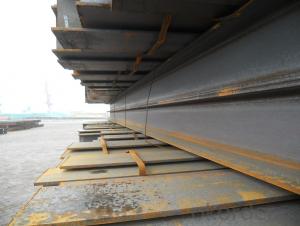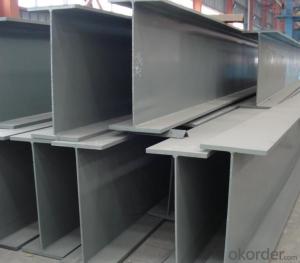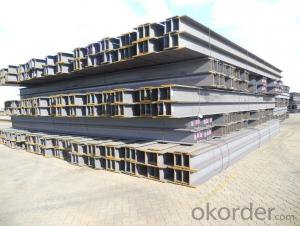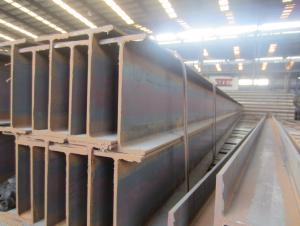High Quality Hot Rolled Structure Steel Jis Standard H Beam
- Loading Port:
- Tianjin
- Payment Terms:
- TT OR LC
- Min Order Qty:
- 25 m.t.
- Supply Capability:
- 1000 m.t./month
OKorder Service Pledge
OKorder Financial Service
You Might Also Like
roduct Description:
Specifications of Hot Rolled Steel H-beam
1. Standard: GB
2. Grade: Q235 or Equivalent
3. Length: 6m,10m, 12m as following table
4. Invoicing on theoretical weight or actual weight as customer request
5.Payment: TT or L/C
6. Sizes:
Category | model (height*width)/ (mm×mm) | Section size/mm | Cross-section area/cm2 | Theoretical Weight/(kg/m) | Moment of inertia/cm4 | radius/cm | Section modulus/cm3 | |||||||
H | B | t1 | t2 | r | Ix | Iy | ix | iy | Wx | Wy | ||||
HW | 100×100 | 100 | 100 | 6 | 8 | 8 | 21.59 | 16.9 | 386 | 134 | 4.23 | 2.49 | 77.1 | 26.7 |
125×125 | 125 | 125 | 6.5 | 9 | 8 | 30.00 | 23.6 | 843 | 293 | 5.30 | 3.13 | 135 | 46.9 | |
150×150 | 150 | 150 | 7 | 10 | 8 | 39.65 | 31.1 | 1620 | 563 | 6.39 | 3.77 | 216 | 75.1 | |
175×175 | 175 | 175 | 7.5 | 11 | 13 | 51.43 | 40.4 | 2918 | 983 | 7.53 | 4.37 | 334 | 112 | |
200×200 | 200 | 200 | 8 | 12 | 13 | 63.53 | 49.9 | 4717 | 1601 | 8.62 | 5.02 | 472 | 160 | |
200 | 204 | 12 | 12 | 13 | 71.53 | 56.2 | 4984 | 1701 | 8.35 | 4.88 | 498 | 167 | ||
250×250 | 244 | 252 | 11 | 11 | 13 | 81.31 | 63.8 | 8573 | 2937 | 10.27 | 6.01 | 703 | 233 | |
250 | 250 | 9 | 14 | 13 | 91.43 | 71.8 | 10689 | 3648 | 10.81 | 6.32 | 855 | 292 | ||
250 | 255 | 14 | 14 | 13 | 103.93 | 81.6 | 11340 | 3875 | 10.45 | 6.11 | 907 | 304 | ||
HM | 150×100 | 148 | 100 | 6 | 9 | 8 | 26.35 | 20.7 | 995.3 | 150.3 | 6.15 | 2.39 | 134.5 | 30.1 |
200×150 | 194 | 150 | 6 | 9 | 8 | 38.11 | 29.9 | 2586 | 506.6 | 8.24 | 3.65 | 266.6 | 67.6 | |
250×175 | 244 | 175 | 7 | 11 | 13 | 55.49 | 43.6 | 5908 | 983.5 | 10.32 | 4.21 | 484.3 | 112.4 | |
HN | 100×50 | 100 | 50 | 5 | 7 | 8 | 11.85 | 9.3 | 191.0 | 14.7 | 4.02 | 1.11 | 38.2 | 5.9 |
125×60 | 125 | 60 | 6 | 8 | 8 | 16.69 | 13.1 | 407.7 | 29.1 | 4.94 | 1.32 | 65.2 | 9.7 | |
150×75 | 150 | 75 | 5 | 7 | 8 | 17.85 | 14.0 | 645.7 | 49.4 | 6.01 | 1.66 | 86.1 | 13.2 | |
175×90 | 175 | 90 | 5 | 8 | 8 | 22.90 | 18.0 | 1174 | 97.4 | 7.16 | 2.06 | 134.2 | 21.6 | |
200×100 | 198 | 99 | 4.5 | 7 | 8 | 22.69 | 17.8 | 1484 | 113.4 | 8.09 | 2.24 | 149.9 | 22.9 | |
200 | 100 | 5.5 | 8 | 8 | 26.67 | 20.9 | 1753 | 133.7 | 8.11 | 2.24 | 175.3 | 26.7 | ||
250×125 | 248 | 124 | 5 | 8 | 8 | 31.99 | 25.1 | 3346 | 254.5 | 10.23 | 2.82 | 269.8 | 41.1 | |
250 | 125 | 6 | 9 | 8 | 36.97 | 29.0 | 3868 | 293.5 | 10.23 | 2.82 | 309.4 | 47.0 | ||
300×150 | 298 | 149 | 5.5 | 8 | 13 | 40.80 | 32.0 | 5911 | 441.7 | 12.04 | 3.29 | 396.7 | 59.3 | |
300 | 150 | 6.5 | 9 | 13 | 46.78 | 36.7 | 6829 | 507.2 | 12.08 | 3.29 | 455.3 | 67.6 | ||
350×175 | 346 | 174 | 6 | 9 | 13 | 52.45 | 41.2 | 10456 | 791.1 | 14.12 | 3.88 | 604.4 | 90.9 | |
350 | 175 | 7 | 11 | 13 | 62.91 | 49.4 | 12980 | 983.8 | 14.36 | 3.95 | 741.7 | 112.4 | ||
400×150 | 400 | 150 | 8 | 13 | 13 | 70.37 | 55.2 | 17906 | 733.2 | 15.95 | 3.23 | 895.3 | 97.8 | |
HT | 100×50 | 95 | 48 | 3.2 | 4.5 | 8 | 7.62 | 6.0 | 109.7 | 8.4 | 3.79 | 1.05 | 23.1 | 3.5 |
97 | 49 | 4 | 5.5 | 8 | 9.38 | 7.4 | 141.8 | 10.9 | 3.89 | 1.08 | 29.2 | 4.4 | ||
100×100 | 96 | 99 | 4.5 | 6 | 8 | 16.21 | 12.7 | 272.7 | 97.1 | 4.10 | 2.45 | 56.8 | 19.6 | |
125×60 | 118 | 58 | 3.2 | 4.5 | 8 | 9.26 | 7.3 | 202.4 | 14.7 | 4.68 | 1.26 | 34.3 | 5.1 | |
120 | 59 | 4 | 5.5 | 8 | 11.40 | 8.9 | 259.7 | 18.9 | 4.77 | 1.29 | 43.3 | 6.4 | ||
125×125 | 119 | 123 | 4.5 | 6 | 8 | 20.12 | 15.8 | 523.6 | 186.2 | 5.10 | 3.04 | 88.0 | 30.3 | |
150×75 | 145 | 73 | 3.2 | 4.5 | 8 | 11.47 | 9.0 | 383.2 | 29.3 | 5.78 | 1.60 | 52.9 | 8.0 | |
147 | 74 | 4 | 5.5 | 8 | 14.13 | 11.1 | 488.0 | 37.3 | 5.88 | 1.62 | 66.4 | 10.1 | ||
150×100 | 139 | 97 | 4.5 | 4.5 | 8 | 13.44 | 10.5 | 447.3 | 68.5 | 5.77 | 2.26 | 64.4 | 14.1 | |
142 | 99 | 4.5 | 6 | 8 | 18.28 | 14.3 | 632.7 | 97.2 | 5.88 | 2.31 | 89.1 | 19.6 | ||
150×150 | 144 | 148 | 5 | 7 | 8 | 27.77 | 21.8 | 1070 | 378.4 | 6.21 | 3.69 | 148.6 | 51.1 | |
147 | 149 | 6 | 8.5 | 8 | 33.68 | 26.4 | 1338 | 468.9 | 6.30 | 3.73 | 182.1 | 62.9 | ||
175×90 | 168 | 88 | 3.2 | 4.5 | 8 | 13.56 | 10.6 | 619.6 | 51.2 | 6.76 | 1.94 | 73.8 | 11.6 | |
171 | 89 | 4 | 6 | 8 | 17.59 | 13.8 | 852.1 | 70.6 | 6.96 | 2.00 | 99.7 | 15.9 | ||
175×175 | 167 | 173 | 5 | 7 | 13 | 33.32 | 26.2 | 1731 | 604.5 | 7.21 | 4.26 | 207.2 | 69.9 | |
172 | 175 | 6.5 | 9.5 | 13 | 44.65 | 35.0 | 2466 | 849.2 | 7.43 | 4.36 | 286.8 | 97.1 | ||
200×100 | 193 | 98 | 3.2 | 4.5 | 8 | 15.26 | 12.0 | 921.0 | 70.7 | 7.77 | 2.15 | 95.4 | 14.4 | |
196 | 99 | 4 | 6 | 8 | 19.79 | 15.5 | 1260 | 97.2 | 7.98 | 2.22 | 128.6 | 19.6 | ||
200×150 | 188 | 149 | 4.5 | 6 | 8 | 26.35 | 20.7 | 1669 | 331.0 | 7.96 | 3.54 | 177.6 | 44.4 | |
Usage & Applications of Hot Rolled Steel H-beam
Commercial building structure ;Pre-engineered buildings; Machinery support structure; Prefabricated structure; Medium scale bridges; Ship-building structure. etc.

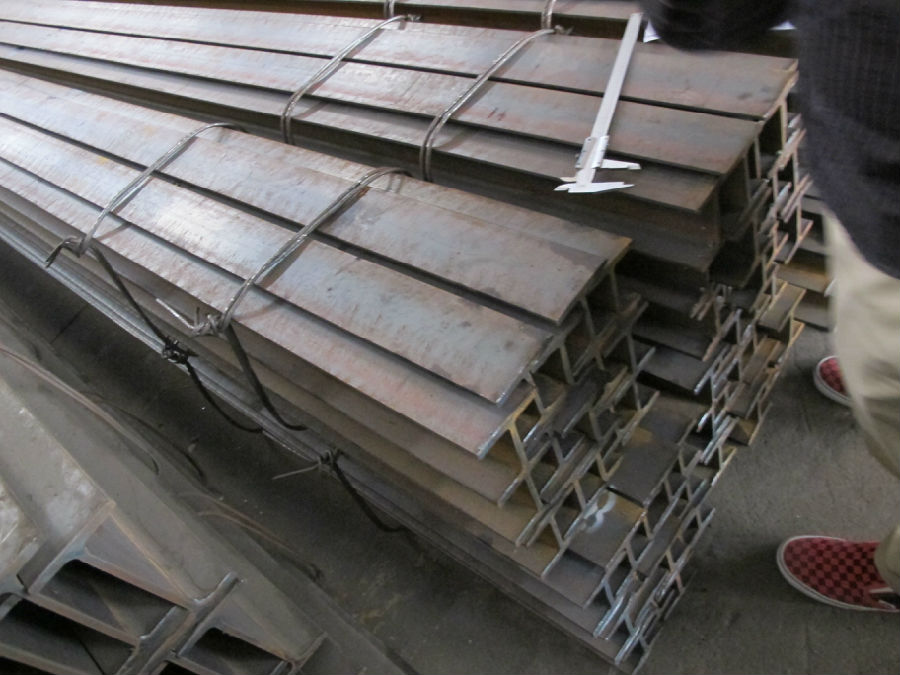
Packaging & Delivery of Hot Rolled Steel H-beam
1. Packing: it is nude packed in bundles by steel wire rod
2. Bundle weight: not more than 3.5MT for bulk vessel; less than 3 MT for container load
3. Marks:
Color marking: There will be color marking on both end of the bundle for the cargo delivered by bulk vessel. That makes it easily to distinguish at the destination port.
Tag mark: there will be tag mark tied up on the bundles. The information usually including supplier logo and name, product name, made in China, shipping marks and other information request by the customer.
If loading by container the marking is not needed, but we will prepare it as customer request.
4. Transportation: the goods are delivered by truck from mill to loading port, the maximum quantity can be loaded is around 40MTs by each truck. If the order quantity cannot reach the full truck loaded, the transportation cost per ton will be little higher than full load.
5. Delivered by container or bulk vessel
Production flow of Hot Rolled Steel H-beam
Material prepare (billet) —heat up—rough rolling—precision rolling—cooling—packing—storage and transportation
- Q:What are the different welding techniques used for steel H-beams?
- There are several welding techniques commonly used for steel H-beams. These techniques include: 1. Arc Welding: This is the most common welding technique used for steel H-beams. It involves the use of an electric arc between an electrode and the base metal to create the weld. Arc welding can be further divided into several sub-categories, such as shielded metal arc welding (SMAW), gas metal arc welding (GMAW), and flux-cored arc welding (FCAW). Each of these sub-categories has its own advantages and disadvantages, and the choice of technique depends on factors such as the thickness of the steel and the desired weld quality. 2. Gas Tungsten Arc Welding (GTAW): Also known as TIG (tungsten inert gas) welding, this technique uses a non-consumable tungsten electrode to create the weld. A separate filler metal is usually added to the weld pool manually. GTAW is known for its high-quality welds and is often used for applications that require precision and aesthetic appeal. 3. Submerged Arc Welding (SAW): This technique involves the use of a continuously fed wire electrode and a granular flux that covers the weld area. The arc is maintained below a layer of flux, which protects the weld from atmospheric contamination. SAW is commonly used for welding thick steel sections and is known for its high deposition rate and deep penetration. 4. Laser Beam Welding (LBW): This technique uses a highly focused laser beam to create the weld. LBW is known for its high precision and narrow heat-affected zone, making it suitable for welding thin steel H-beams. However, it is a relatively expensive technique and requires specialized equipment. The choice of welding technique for steel H-beams depends on various factors such as the thickness of the steel, the desired weld quality, production volume, and available equipment. Each technique has its own advantages and limitations, and it is important to select the most appropriate technique based on the specific requirements of the project.
- Q:Can steel H-beams be used for residential garages?
- Yes, steel H-beams can be used for residential garages. H-beams are commonly used in construction due to their strength and durability. They provide excellent structural support, making them suitable for applications such as garage construction. Steel H-beams offer several advantages, including resistance to bending and warping, which ensures the stability of the garage structure. Additionally, steel H-beams have a high load-bearing capacity, allowing them to support heavy loads such as vehicles and storage items. Using steel H-beams for residential garages can result in a sturdy and long-lasting structure that provides ample protection for your vehicles and belongings.
- Q:Can steel H-beams be used in sports arena structures?
- Yes, steel H-beams can be used in sports arena structures. Steel H-beams are commonly used in construction due to their high strength-to-weight ratio, which makes them suitable for supporting heavy loads. Sports arenas require sturdy structural elements to support the weight of the roof, seating, and other equipment. H-beams provide the necessary strength and stability to withstand the forces exerted on the structure during events. Additionally, steel H-beams can be easily fabricated and assembled, allowing for efficient construction of sports arena structures. Their versatility also allows architects and engineers to design unique and innovative arena layouts, accommodating various seating arrangements and architectural features. Furthermore, steel H-beams offer durability and resistance to environmental factors such as corrosion, making them ideal for long-lasting sports arena structures. The material's low maintenance requirements also contribute to its popularity in construction projects. Overall, steel H-beams are a reliable and commonly used choice for sports arena structures, providing the necessary strength, versatility, and durability required for such large-scale projects.
- Q:What are the considerations when designing for blast resistance in Steel H-Beams?
- When designing for blast resistance in Steel H-Beams, there are several key considerations to keep in mind. Firstly, the material selection plays a crucial role. High-strength steel, such as ASTM A572 or A992, is typically recommended for blast-resistant designs due to its ability to withstand high impact loads. The steel's yield strength and ductility should be carefully evaluated to ensure it can withstand the blast forces without failure. The geometry and dimensions of the H-Beams are also important factors to consider. The size, shape, and orientation of the beam will impact its resistance to blast loads. The beam's depth and flange width should be optimized to provide sufficient strength and stiffness while minimizing weight. The connection details between beams and other structural elements should also be designed to withstand blast forces and prevent progressive collapse. Furthermore, the design should account for the anticipated blast loading. The blast pressure, duration, and impulse should be properly calculated based on the specific explosive scenario. The loading should consider both the direct impact on the beam and the potential for reflected or transmitted waves that could amplify the forces. Dynamic analysis techniques, such as finite element analysis, can be employed to accurately simulate the blast response and verify the structural integrity. It is also essential to consider the overall structural system. Blast-resistant designs often incorporate redundancy and alternate load paths to mitigate the effects of localized failures. The beams should be adequately braced and connected to resist lateral displacements and prevent collapse. The design should also consider the potential for progressive collapse and incorporate measures to arrest its propagation. Lastly, any blast-resistant design must adhere to relevant codes, standards, and guidelines. Various organizations, such as the American Society of Civil Engineers (ASCE), provide specific design criteria and recommendations for blast-resistant structures. Compliance with these standards ensures the design meets the necessary safety requirements and provides consistent levels of protection. In conclusion, designing for blast resistance in Steel H-Beams requires careful consideration of material selection, geometry, loading conditions, structural system, and adherence to applicable standards. By addressing these considerations, engineers can create robust and resilient structures capable of withstanding the destructive forces of a blast.
- Q:What is the maximum length of a steel H-beam that can be manufactured?
- The maximum length of a steel H-beam that can be made depends on various factors, including the manufacturing process, transportation limitations, and practical constraints. Concerning the manufacturing process, steel H-beams are typically produced in set lengths, which can vary depending on the specific steel mill or manufacturer. These standard lengths typically range from 20 to 60 feet (6 to 18 meters). However, it is worth noting that longer lengths can often be requested or fabricated based on specific project requirements. Transportation restrictions also play a significant role in determining the maximum length of a steel H-beam. The beam's length must be able to fit within the constraints of transportation methods such as trucks, trains, or ships. Each of these transportation methods has its own size limitations, and going beyond these limits may necessitate special arrangements, permits, or even partial disassembly of the beam. Lastly, practical limitations must be considered when determining the maximum length of a steel H-beam. Lengthier beams can pose challenges in terms of handling, maneuvering, and installation at construction sites. The weight and size of the beam can make transportation and lifting more difficult, potentially requiring specialized equipment or additional manpower. In conclusion, while there are standard lengths for steel H-beams, the maximum length that can be manufactured is influenced by the manufacturing process, transportation restrictions, and practical considerations. Custom orders, transportation logistics, and practical limitations all contribute to determining the maximum length of a steel H-beam.
- Q:Are there any limitations on the span length of steel H-beams?
- Yes, there are limitations on the span length of steel H-beams. The span length refers to the distance between the supports or columns that the H-beam is placed on. The maximum span length for steel H-beams depends on various factors such as the type and grade of steel used, the design load or weight that the beam needs to support, and the allowable deflection or bending of the beam. In general, the span length of steel H-beams can vary greatly. Smaller H-beams with lower load requirements can have longer spans, while larger H-beams with higher load requirements may have shorter spans. Additionally, the span length may also be limited by local building codes and regulations. Structural engineers and architects typically calculate the maximum span length of steel H-beams using engineering principles and design software. They consider factors such as the beam's moment of inertia, section modulus, and load distribution to determine the appropriate span length for a given application. It is important to consult with a qualified structural engineer or design professional when determining the span length of steel H-beams for a specific project. They will be able to analyze the specific requirements and conditions to provide accurate and safe recommendations for the maximum span length of the H-beams.
- Q:Can steel H-beams be used for water treatment plants?
- Yes, steel H-beams can be used for water treatment plants. Steel H-beams are commonly used in the construction industry due to their strength, durability, and load-bearing capabilities. These characteristics make them suitable for supporting various structures in water treatment plants, such as tanks, platforms, and walkways. Additionally, steel H-beams can withstand harsh environmental conditions, corrosion, and chemical exposure, making them an ideal choice for water treatment facilities.
- Q:What are the different grades of steel used for H-beams?
- The different grades of steel commonly used for H-beams include A36, A572, and A992.
- Q:How do steel H-beams compare to other types of structural beams?
- Steel H-beams are commonly used in construction and engineering projects due to their numerous advantages compared to other types of structural beams. One significant advantage of steel H-beams is their high strength-to-weight ratio. Due to their unique shape, H-beams are able to distribute weight evenly along their length, making them exceptionally strong and capable of supporting heavy loads. This characteristic allows for the construction of longer spans and taller structures, without the need for additional support columns or beams. Another advantage of steel H-beams is their versatility. They can be easily fabricated and customized to fit specific project requirements. H-beams can be cut, welded, and drilled, allowing for greater flexibility in design and construction. This versatility makes them suitable for a wide range of applications, from building construction to bridge and infrastructure projects. In addition, steel H-beams have excellent resistance to bending and twisting forces. This is particularly beneficial in earthquake-prone areas, as the beams can absorb and distribute seismic forces, ensuring the structural integrity of buildings and minimizing damage. Furthermore, steel H-beams have a long lifespan and require minimal maintenance. They are highly durable, resistant to corrosion, and unaffected by environmental conditions such as humidity or temperature changes. This durability ensures the longevity of structures and reduces the need for costly repairs or replacements. Lastly, steel H-beams are cost-effective. Although initially more expensive than some other types of structural beams, their long lifespan and low maintenance requirements ultimately result in lower overall costs over time. Additionally, their high strength-to-weight ratio allows for lighter foundations and reduced material usage, further contributing to cost savings. In summary, steel H-beams offer numerous advantages compared to other types of structural beams. Their high strength-to-weight ratio, versatility, resistance to bending and twisting, durability, and cost-effectiveness make them a popular choice in construction and engineering projects.
- Q:Can steel H-beams be used in automotive manufacturing?
- Certainly! Steel H-beams have a multitude of applications in automotive manufacturing. These beams, also referred to as I-beams or universal beams, are renowned in the construction industry for their durability and strength. However, they are equally valuable in the automotive sector. H-beams can be effectively incorporated into vehicle frames, chassis, and suspension systems. Their exceptional structural support allows them to bear heavy loads and endure impacts, thus guaranteeing the safety and stability of the vehicle. Moreover, H-beams are perfect for the production of engine components, including connecting rods and crankshafts, owing to their high tensile strength and resistance against bending and twisting forces. Furthermore, steel H-beams offer additional benefits such as cost-effectiveness, easy availability, and simple fabrication. They can be easily obtained from steel suppliers and are accessible in a wide assortment of sizes and specifications, making them well-suited for various automotive applications. Additionally, steel is a recyclable material, aligning with the growing emphasis on sustainability and environmental consciousness within the automotive industry. In conclusion, steel H-beams are undeniably valuable in automotive manufacturing due to their strength, durability, versatility, and cost-effectiveness. Their utilization in vehicle frames, suspension systems, and engine components enhances the overall safety, stability, and performance of automobiles.
1. Manufacturer Overview |
|
|---|---|
| Location | |
| Year Established | |
| Annual Output Value | |
| Main Markets | |
| Company Certifications | |
2. Manufacturer Certificates |
|
|---|---|
| a) Certification Name | |
| Range | |
| Reference | |
| Validity Period | |
3. Manufacturer Capability |
|
|---|---|
| a)Trade Capacity | |
| Nearest Port | |
| Export Percentage | |
| No.of Employees in Trade Department | |
| Language Spoken: | |
| b)Factory Information | |
| Factory Size: | |
| No. of Production Lines | |
| Contract Manufacturing | |
| Product Price Range | |
Send your message to us
High Quality Hot Rolled Structure Steel Jis Standard H Beam
- Loading Port:
- Tianjin
- Payment Terms:
- TT OR LC
- Min Order Qty:
- 25 m.t.
- Supply Capability:
- 1000 m.t./month
OKorder Service Pledge
OKorder Financial Service
Similar products
New products
Hot products
Related keywords
